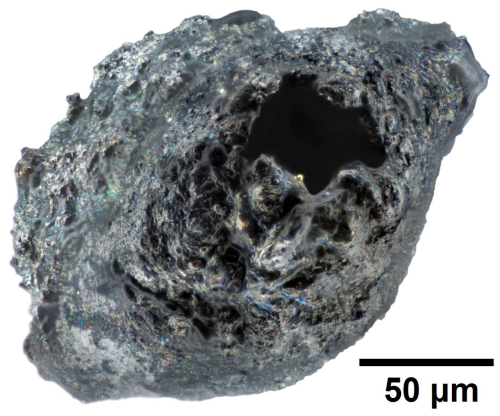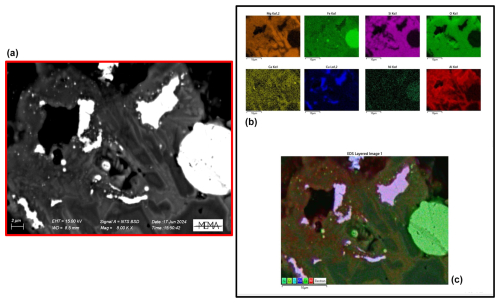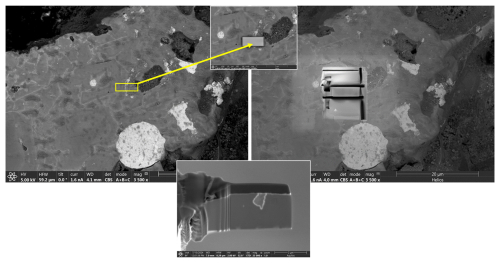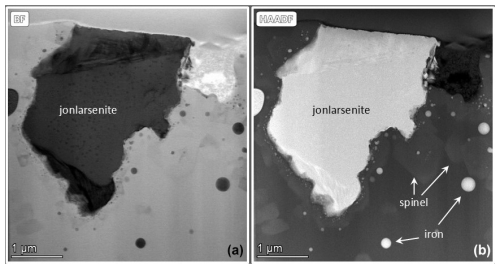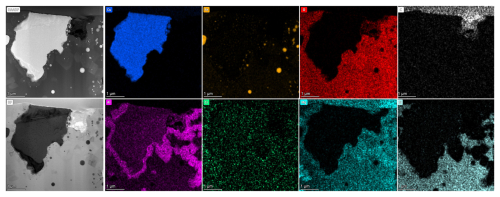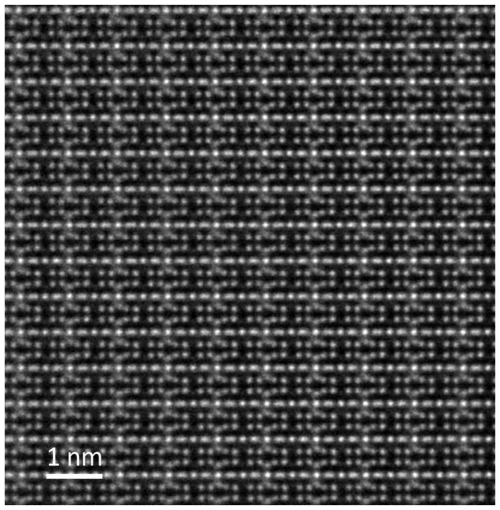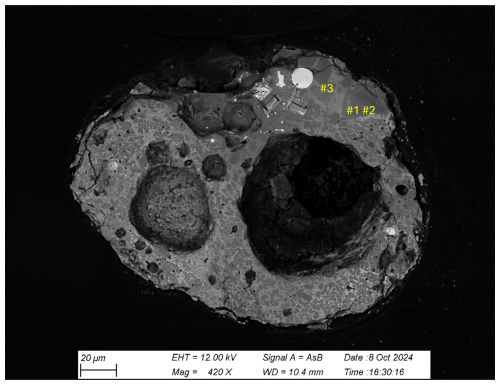the Creative Commons Attribution 4.0 License.
the Creative Commons Attribution 4.0 License.
Jonlarsenite, Al4Cu9, a new intermetallic phase in the Al–Cu system discovered in a micrometeorite from Oslo, Norway
Jan B. Kihle
Guangming Cheng
Jinping Hu
Nan Yao
Yunbin Guan
Paul D. Asimow
Paul J. Steinhardt
During project STARDUST, a systematic decade-long search for micrometeorites in Norway, over 5500 specimens were recovered. Among them, a micrometeorite labelled NMM/L2, collected from a rooftop in Oslo, Norway, revealed the presence of a previously unknown Al–Cu intermetallic alloy with Al4Cu9 stoichiometry. This new phase has been approved by the IMA Commission on New Minerals, Nomenclature and Classification as a new mineral species with the name jonlarsenite (IMA 2024-078a). The microspherule (∼200 µm in diameter) exhibits a scoriaceous morphology and mineralogical features consistent with micrometeorites, including the presence of olivine, oxides, Fe–Ni metal beads, and Ca-rich silicate glass. Jonlarsenite occurs as ∼2 µm grains intimately intergrown with Cu-bearing aluminum and is associated with magnesian olivine, spinel, taenite, and silicate glass. Its extraterrestrial origin is revealed by oxygen isotope compositions and chondritic bulk chemistry, similar to previously reported Al- and Cu-bearing meteoritic materials.
Characterisation by electron probe microanalysis (EPMA), STEM energy-dispersive X-ray spectrometry (STEM-EDS), and HR-TEM indicated the mineral to be cubic, space group P-43m, with a≈8.70 Å and a calculated density of 6.979 g cm−3. The ideal chemical formula is Al4Cu9, with minor Fe substituting for both Al and Cu. Selected area electron diffraction (SAED) and high-angle annular dark-field scanning TEM (HAADF-STEM) imaging showed a perfect match with the known ordered structure of synthetic γ-Al4Cu9. Due to micrometre-scale grain size, physical properties could not be measured. Jonlarsenite expands the suite of known natural intermetallic Al–Cu(–Fe) phases and highlights the significance of micrometeorites as repositories of exotic materials formed under extreme astrophysical conditions.
- Article
(10637 KB) - Full-text XML
- BibTeX
- EndNote
Over the past decade, project STARDUST (e.g. Larsen, 2019) has conducted a systematic and meticulous survey aimed at identifying and collecting micrometeorites from urban environments across Europe. This initiative, unique in its urban focus, has led to the recovery of over 5500 micrometeorite candidates, primarily from the roofs of buildings. The project leverages the fact that Earth's atmosphere is continuously bombarded by extraterrestrial particles – ranging from sub-millimetre dust to larger meteoroids – which can survive atmospheric entry and accumulate on flat urban surfaces, where they are accessible for collection and study. Unlike traditional micrometeorite searches in remote or polar environments, STARDUST demonstrates that even human-dominated settings can yield scientifically valuable cosmic material when analysed with rigorous protocols.
In the context of a targeted re-examination of the collected material – focusing specifically on samples potentially containing aluminum–copper (Al–Cu) metallic phases – a comprehensive visual screening was undertaken. This process relied on macroscopic and microscopic criteria, such as metallic lustre, morphology, vesicular or scoriaceous texture, and the presence of silvery metallic particles on the surface. This screening led to the identification of two particularly promising micrometeorites. Both were discovered at different times by Jon Larsen on the roofs of separate buildings located in Oslo, Norway (Bindi et al., 2025).
In this study, we focus on one of these two samples, designated NMM/L2 (Fig. 1), which was found on 15 August 2022 on the roof of a modern industrial facility near Skedsmokorset, just north of Oslo (coordinates: 60.0176196° N, 11.0578908° E). The building, operated by Bertel O. Steen Logistics, was constructed in 2017–2018, ensuring a well-constrained temporal window for micrometeorite accumulation. Collection was carried out by systematically gathering loose particulate material from the roof surface, which was then examined under a binocular microscope to isolate spheroidal particles in the size range of 50–500 µm.
Sample NMM/L2 consists of an elongated spherule approximately 200 µm in diameter, characterised by a dark grey colour and a markedly scoriaceous surface featuring vesicles – a morphology reminiscent of other known extraterrestrial Al- and Cu-bearing materials such as KT-01 (Suttle et al., 2019) and fragments of the Khatyrka meteorite (Lin et al., 2017). Detailed mineralogical and geochemical analysis of NMM/L2 led to the identification of a previously undescribed Al–Cu alloy with Al4Cu9 stoichiometry. This new phase has been approved by the Commission on New Minerals, Nomenclature and Classification of the International Mineralogical Association (CNMNC-IMA) as a new mineral species with the name jonlarsenite (IMA 2024-078a), in honour of Jon Larsen (b. 1959), who played a pivotal role in the urban micrometeorite search. The type material (polished section of NMM/L2) is deposited in the collections of the Natural History Museum, University of Oslo, Postboks 1172, Blindern, 0318 Oslo, Norway, under registration number KNR 44452.
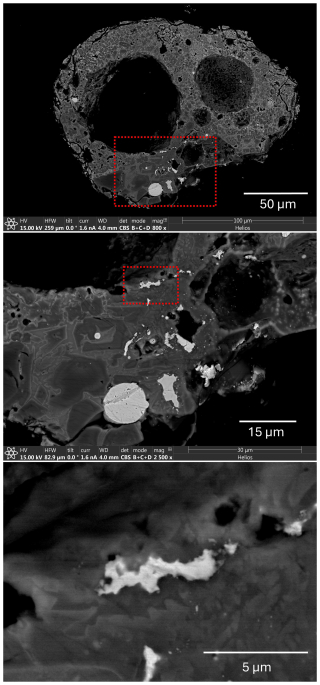
Figure 2SEM backscattered electron (BSE) image of the polished section of NMM/L2. Large degassing vesicles are clearly visible. The red dashed rectangles indicate the region to be enlarged in the figures below. Small jonlarsenite fragment (bottom) used to get electron microprobe analyses.
The micrometeorite containing jonlarsenite represents the fifth documented case of an extraterrestrial object hosting metallic Al–Cu intermetallic phases, following the discoveries of Khatyrka (Bindi et al., 2012; MacPherson et al., 2013; Lin et al., 2017; Meier et al., 2018), KT-01 from Sudan (Suttle et al., 2019; Ma et al., 2023), FB-A1 from southern Italy (Agrosì et al., 2025), and NG-1 from the Democratic Republic of the Congo (Genge et al., 2025).
The micrometeorite exhibits features consistent with an extraterrestrial origin (Bindi et al., 2025), including a broadly chondritic bulk composition, olivine-rich silicate phases, and Fe–Ni metal beads, as defined by the micrometeorite classification framework of Genge et al. (2008). The Ca-rich silicate glass phase and mineral assemblage – including magnesian olivine, spinel, taenite, iron, nickel, and compositionally diverse silicate glass – reinforce this classification (Bindi et al., 2025). Jonlarsenite is found in intimate contact with Cu-bearing aluminum, and its fine-scale textural and structural features were revealed using a suite of advanced analytical techniques: high-resolution scanning electron microscopy (SEM), electron microprobe analysis (EMPA), focused ion beam (FIB)–SEM, and transmission electron microscopy (TEM). Furthermore, the extraterrestrial nature of NMM/L2 was substantiated by oxygen isotope measurements using secondary ion mass spectrometry (SIMS) on coexisting silicate phases.
2.1 Appearance and physical properties
Jonlarsenite occurs as subhedral to anhedral grains up to approximately 2 µm in maximum dimension (Figs. 2–3), embedded within the silicate matrix of the micrometeorite. These grains represent the type material for this newly identified mineral. Due to their extremely small size and intergrowth with other phases, individual jonlarsenite crystals are only characterisable using high-resolution electron microscopy techniques.
In transmitted and reflected light, jonlarsenite is opaque. Its colour, lustre, streak, hardness, tenacity, cleavage, fracture, and other macroscopic physical properties could not be directly determined because the small grain size and intimate association with adjacent phases preclude isolation of single crystals for traditional testing. Nevertheless, the mineral exhibits high backscattered electron contrast in SEM images, consistent with its high average atomic number and metallic composition.
The calculated density of jonlarsenite is 6.979 g cm−3, derived from the empirical formula obtained via electron microprobe analyses (see below) and based on the unit-cell parameters determined by transmission electron microscopy (see below). This relatively high density is consistent with its Al–Cu composition, dominated by copper content, and aligns well with values expected for intermetallic compounds of this stoichiometry. The internal structure of jonlarsenite, as revealed by TEM, confirms its crystallinity and supports its classification as a distinct mineral species.
2.2 Chemical composition
Quantitative wavelength-dispersive X-ray spectrometry (WDS) elemental microanalyses (n=2) were carried out using a JEOL 8200 electron microprobe (WDS mode, 12 kV and 5 nA, focused beam). The focused electron beam is ∼150 nm in diameter. Analyses were processed with the CITZAF correction procedure. Analytical results are given in Table 1. Ni was also analysed using Ni metal as standard and found below detection limits (0.03 wt %).
Moreover, given the fine intergrowth of jonlarsenite and Cu-bearing aluminum at the TEM scale (see below) in most of the metal fragments, other analyses (n=4) were obtained by STEM-EDS on a FIB lamella together with X-ray chemical maps (see below). The obtained empirical chemical formulae (on the basis of 13 atoms) can be written as (Al3.55Fe0.45)Σ4.00(Cu8.96Fe0.04)Σ9.00 and (Al3.81Fe0.19)Σ4.00(Cu8.66Fe0.34)Σ9.00, based on electron probe microanalysis (EPMA) and TEM data, respectively. The ideal formula is Al4Cu9, which requires Al 15.88, Cu 84.12, and total 100.00 wt %.
2.3 Crystallography
Conventional bulk or micro-scale X-ray diffraction (XRD) studies on jonlarsenite could not be performed due to the extremely small crystal size of the grains and their complex intergrowth with Cu-bearing aluminum and silicate phases within the micrometeorite. As a result, to investigate the crystallographic structure and confirm the identity of the new phase with synthetic ordered γ-Al4Cu9, we applied the focused ion beam–transmission electron microscopy technique, which is specifically suited for the characterisation of nanoscale mineral phases in heterogeneous matrices.
For this purpose, a thin electron-transparent lamella was extracted from a targeted region of the micrometeorite NMM/L2 (see Figs. 4–5) using a Helios NanoLab G3 UC dual-beam FIB–SEM system. The preparation involved site-specific FIB milling, followed by careful thinning of the sample. To preserve the integrity of the structure and reduce surface amorphisation typically caused by high-energy ion beams, final polishing was performed with a low-energy (2 kV) gallium ion beam. This approach ensured that the region of interest, containing the jonlarsenite grains, remained structurally intact for subsequent high-resolution analyses.
The prepared lamella was then studied using advanced transmission electron microscopy techniques. These included conventional TEM imaging, selected area electron diffraction (SAED), atomic-resolution high-angle annular dark-field scanning TEM (HAADF-STEM) imaging, and energy-dispersive X-ray spectrometry (EDS) elemental mapping (see Fig. 6). All measurements were conducted using a Titan Cubed Themis 300 double Cs-corrected STEM, operated at an accelerating voltage of 300 kV. The instrument is equipped with an extreme field emission gun (X-FEG) and a super-X EDS system, allowing for high spatial resolution and sensitivity in both imaging and chemical analyses.
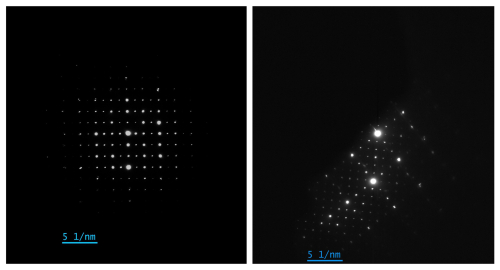
Figure 7TEM SAED patterns taken from the centre of the AlCu phase in the extracted FIB lamella, indicating a cubic symmetry with a≈8.70 Å.
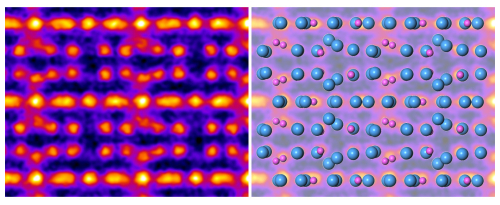
Figure 9Excellent match between the HAADF-STEM image of jonlarsenite superimposed (on the right) on the γ-Al4Cu9 crystal structure reported by Arnberg and Westman (1978).
The SAED patterns and HAADF-STEM images collected from the most chemically homogeneous areas, corresponding to the Al4Cu9 stoichiometry (Figs. 7–8), yielded sharp and well-defined diffraction spots that could be unequivocally indexed with the P-43mγ-Al4Cu9 crystal structure, previously reported by Arnberg and Westman (1978). The observed diffraction patterns match the expected symmetry and periodicities of this cubic intermetallic phase with a=8.70(1) Å, V=659(2) Å3, and Z=4, confirming the identity of jonlarsenite and providing robust crystallographic support for its classification as a new mineral species. Furthermore, Fig. 9 shows the excellent match between the HAADF-STEM image of jonlarsenite and the γ-Al4Cu9 crystal structure reported by Arnberg and Westman (1978).
Table 2Atoms, Wyckoff letter, and fractional atom coordinates (Å) for synthetic Al4Cu9 (Arnberg and Westman, 1978).
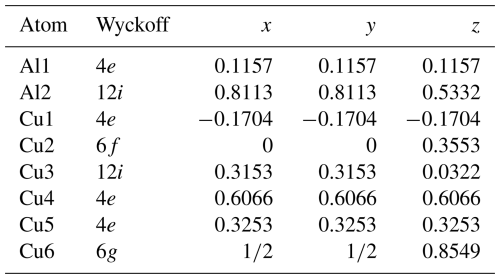
Table 3Calculated X-ray powder diffraction data for jonlarsenite (Icalc>3). The strongest reflections are given in bold.
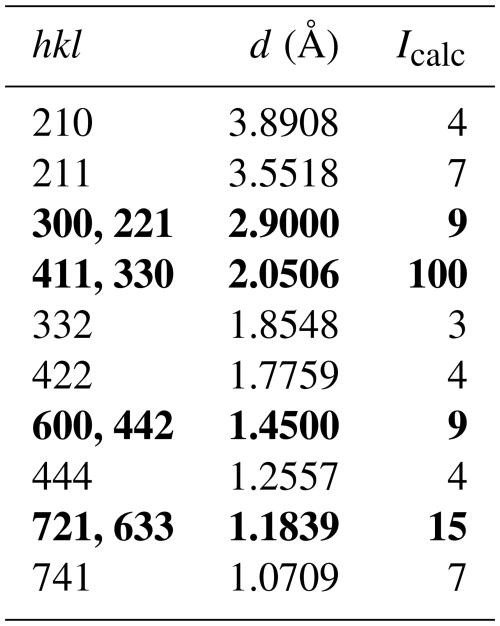
X-ray powder diffraction data were calculated from the atomic coordinates (Table 2) given by Arnberg and Westman (1978) and from cell parameters and the empirical formula from this study, using Powder Cell version 2.4. Calculated X-ray powder diffraction data (data in Å for CuKα1, Bragg–Brentano geometry) are shown in Table 3.
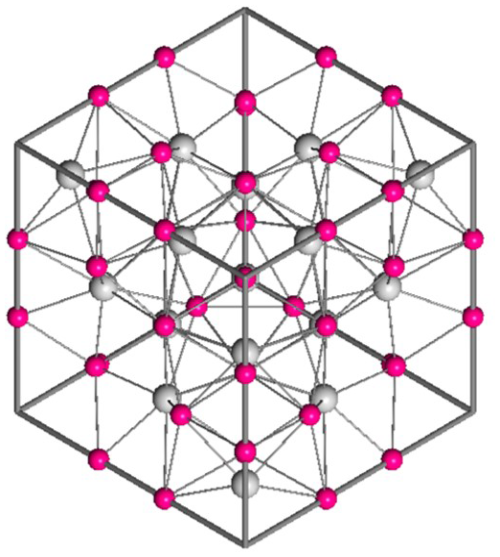
Figure 10The crystal structure of jonlarsenite projected down [111]. Red and grey circles indicate Cu and Al atoms, respectively.
Jonlarsenite exhibits the ordered brass-like structure (Fig. 10) and crystallises in the cubic P-43m space group. In the structure, there are six inequivalent Cu sites. In the first Cu site, Cu is bonded in a 12-coordinate geometry to 6 Cu and 6 Al atoms. There are three shorter (2.49 Å) and three longer (2.62 Å) Cu–Cu bond lengths. There are three shorter (2.55 Å) and three longer (2.58 Å) Cu–Al bond lengths. In the second Cu site, Cu is bonded in a 12-coordinate geometry to 9 Cu and 3 equivalent Al atoms. There is a spread of Cu–Cu bond distances ranging from 2.50–2.56 Å. All Cu–Al bond lengths are 2.56 Å. In the third Cu site, Cu is bonded in a 12-coordinate geometry to 9 Cu and 3 equivalent Al atoms. There are three shorter (2.54 Å) and three longer (2.63 Å) Cu–Cu bond lengths. All Cu–Al bond lengths are 2.44 Å. In the fourth Cu site, Cu is bonded in a 13-coordinate geometry to 7 Cu and 6 Al atoms. There is a spread of Cu–Al bond distances ranging from 2.50–2.79 Å. In the fifth Cu site, Cu is bonded in a 13-coordinate geometry to 9 Cu and 4 equivalent Al atoms. There is a spread of Cu–Cu bond distances ranging from 2.45–2.72 Å. All Cu–Al bond lengths are 2.71 Å. In the sixth Cu site, Cu is bonded in a 11-coordinate geometry to 6 Cu and 5 Al atoms. There is a spread of Cu–Al bond distances ranging from 2.50–2.57 Å. There are two inequivalent Al sites. In the first Al site, Al is bonded in a 9-coordinate geometry to 9 Cu atoms. In the second Al site, Al is bonded in a 11-coordinate geometry to 11 Cu atoms.
2.4 Oxygen isotope measurements
Triple oxygen isotopes were measured at three locations in the micrometeorite's relict olivine (Fig. 11). These were acquired with a Cameca ims 7f-GEO secondary ion mass spectrometer (SIMS). A primary Cs+ beam of +10 kV and ∼3 nA was used to sputter the sample with a spot size of ∼20 µm. Secondary ion signals of −9 keV were collected in peak-jumping mode with either a Faraday cup (FC2, for 16O−) or an electron multiplier (EM, for 17O− and 18O−) under high-mass-resolution conditions that resolve any interferences on the mass peaks of interest. A normal-incidence electron gun (NEG) of −9 keV was used for sample charging compensation. Uncertainties on each data point include counting statistical errors and the standard deviation of repeated measurements of the San Carlos olivine standard. Two data points plot far from the terrestrial fractionation line and on or close to the CCAM line (Fig. 12), indicative of an extraterrestrial origin of the micrometeorite.
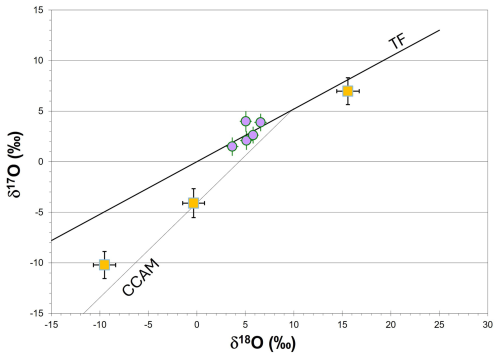
Figure 12A plot of oxygen three-isotope composition as suggested by Clayton et al. (1976) to discriminate between terrestrial and extraterrestrial minerals. The data collected on olivine (yellow squares) are compared to concurrent analyses of San Carlos olivine (violet circles) as a terrestrial standard. The plotted compositional indices, δ18Ovsmow (‰) and δ17Ovsmow (‰), are the difference in and ratios, respectively, compared to the ratios in VSMOW, expressed in parts per mil. Terrestrial minerals fall along the upper gently sloping line (TF); the oxygen isotope compositions measured for NMM/L2 lie along the line corresponding to anhydrous minerals in carbonaceous chondrites (the CCAM).
The identification of jonlarsenite as a new Al–Cu intermetallic phase in the micrometeorite NMM/L2 adds significant value to the growing catalogue of exotic mineral species of cosmochemical origin. Its Al4Cu9 stoichiometry and structure match with the synthetic analogue, confirming its identity as a distinct phase that was previously unrecognised in natural materials. The robust crystallographic determination via SAED and HAADF-STEM, in combination with quantitative compositional data from both EMPA and TEM-EDS, provides unambiguous evidence that jonlarsenite is a natural representative of the ordered (P-43m)γ-brass structure type.
This discovery contributes to an emerging trend in meteoritics and planetary science: the occurrence of metastable or technologically relevant Al–Cu intermetallics in small extraterrestrial bodies. Indeed, only five known meteoritic samples – Khatyrka (Bindi et al., 2012; MacPherson et al., 2013; Lin et al., 2017; Meier et al., 2018), KT-01 (Suttle et al., 2019; Ma et al., 2023), FB-A1 (Agrosì et al., 2025), NG-1 (Genge et al., 2025), and now NMM/L2 – are known to host such alloy materials. Among these, jonlarsenite is the first confirmed natural occurrence of γ-Al4Cu9, a phase of particular interest in materials science due to its structural complexity and physical properties. Its discovery not only expands the diversity of known meteoritic metal phases but also raises intriguing questions about the conditions under which such intermetallics form and persist in space.
The oxygen isotope data from NMM/L2 further support an extraterrestrial origin, with values plotting close to the carbonaceous chondrite anhydrous mineral (CCAM) line, well outside the terrestrial fractionation range. This geochemical fingerprint, in conjunction with the micrometeorite's petrographic features – chondritic silicate mineralogy, Fe–Ni beads, and vesicular surface texture – consolidates its classification as a genuine cosmic particle that survived atmospheric entry.
From a petrogenetic perspective, the formation of jonlarsenite likely reflects high-temperature redox processes that occurred either during parent body alteration or, more plausibly, during peculiar hypervelocity impact events in space (Genge et al., 2025). The intimate association between jonlarsenite and Cu-rich Al suggests rapid quenching from a melt or vapour phase under non-equilibrium conditions. Such environments could be produced by localised shock events or transient heating in the early solar system, possibly facilitated by collisions involving reduced, metal-rich precursor materials.
Furthermore, the urban context of this discovery, as part of project STARDUST, underscores the viability of densely populated environments for recovering scientifically important micrometeorites. The occurrence of jonlarsenite in a spherule collected from a modern building rooftop demonstrates that advanced analytical techniques can extract high-value mineralogical and cosmochemical information from materials gathered outside of traditional field locations like Antarctica or desert regions. This represents a paradigm shift in micrometeorite research, allowing for more widespread and accessible studies of the flux and composition of extraterrestrial matter reaching Earth today.
In conclusion, jonlarsenite not only enriches the mineralogical diversity of natural Al–Cu alloys but also offers insights into the complex thermal and redox histories of planetary materials. Its discovery, enabled by both systematic collection efforts and cutting-edge analytical methods, illustrates how even micrometre-scale phases in small cosmic particles can yield profound clues about processes operating in our solar system and beyond.
All the collected data have been reported in the paper and are available from the authors upon request.
The study was conceived by LB, JBK, and PJS; GC and NY carried out the FIB-TEM study; and JH, CM, and PDA performed the SEM study. YG carried out the SIMS analysis. LB wrote the paper. All the authors commented on the final version of the paper.
At least one of the (co-)authors is a member of the editorial board of European Journal of Mineralogy. The peer-review process was guided by an independent editor, and the authors also have no other competing interests to declare.
Publisher's note: Copernicus Publications remains neutral with regard to jurisdictional claims made in the text, published maps, institutional affiliations, or any other geographical representation in this paper. While Copernicus Publications makes every effort to include appropriate place names, the final responsibility lies with the authors. Views expressed in the text are those of the authors and do not necessarily reflect the views of the publisher.
The paper benefited from the official reviews of the two anonymous reviewers. Associate Editor Cristiano Ferraris is thanked for his efficient handling of the paper. The authors also thank Simona Palenscar (IFE, Kjeller, Norway) for the preliminary SEM observation of the micrometeorite sample. SEM, EBSD, EDS, and EPMA analyses were carried out at the Caltech GPS Division Analytical Facility, which is supported, in part, by NSF grants EAR-2117942 and DMR-0080065. The authors acknowledge the use of Princeton's Imaging and Analysis Center, which is partially supported by the Princeton Center for Complex Materials, a National Science Foundation (NSF)-MRSEC programme (DMR-2011750).
The research was supported by the Space It Up project funded by the Italian Space Agency, ASI, and the Ministry of University and Research, MUR, under contract no. 2024-5-E.0-CUP n. I53D24000060005.
This paper was edited by Cristiano Ferraris and reviewed by two anonymous referees.
Agrosì, G., Manzari, P., Mele, D., Tempesta, G., Rizzo, F., Catelani, T., Cheng, G., Yao, N., Villeneuve, J., and Bindi, L.: Unique (Al,Cu)-alloys discovered in a micrometeorite from Southern Italy, Commun. Earth Environ., 6, 271, https://doi.org/10.1038/s43247-025-02245-w, 2025.
Arnberg, L. and Westman, S.: Crystal perfection in a noncentrosymmetric alloy. Refinement and test of twinning of the γ-Cu9Al4 structure, Acta Crystallogr., A34, 399–404, 1978.
Bindi, L., Eiler, J., Guan, Y., Hollister, L. S., MacPherson, G. J., Steinhardt, P. J., and Yao, N.: Evidence for the extra-terrestrial origin of a natural quasicrystal, P. Natl. Acad. Sci. USA, 109, 1396–1401, 2012.
Bindi, L., Larsen, J., Kihle, J. B., Cheng, G., Hu, J., Yao, N., Ma, C., Guan, Y., Asimow, P. D., and Steinhardt, P. J.: Metallic messengers from the cosmos: Rare (Al,Cu)-bearing meteorites from the Project Stardust collection, Met. Plan. Sci., 60, 1609–1620, 2025.
Clayton, R. N., Onuma, N., and Mayeda, T. K.: A classification of meteorites based on oxygen isotopes. Earth Planet. Sc. Lett., 30, 10–18, 1976.
Genge, M. J., Engrand, C., Gounelle, M., and Taylor, S.: The classification of micrometeorites, Met. Plan. Sci., 43, 497–515, 2008.
Genge, M. J., Van Ginneken, M., Ma, C., Suttle, M. D., Almeida, N., Kita, N. T., Zhang, M., and Bindi, L.: The first Al-Cu-alloy-bearing unmelted micrometeorite suggests contributions from the disrupted ureilite protoplanet, Earth Planet. Sc. Lett., 656, 119276, https://doi.org/10.1016/j.epsl.2025.119276, 2025.
Larsen, J.: On the trail of stardust: The Guide to Finding Micrometeorites: Tools, Techniques, and Identification, Voyageur Press, 2019, ISBN 10 0760364583, 2019.
Lin, C., Hollister, L. S., MacPherson, G. J., Bindi, L., Ma, C., Andronicos, C. L., and Steinhardt, P. J.: Evidence of redox reaction in the quasicrystal-bearing Khatyrka meteorite reveals multi-stage formation process, Sci. Rep., 7, 1637, https://doi.org/10.1038/s41598-017-01445-5, 2017.
Ma, C., Hu, J., Suttle, M. D., Guan, Y., Sharp, T. G., Asimow, P. D., Steinhardt, P. J., and Bindi, L.: Al-Cu-Fe alloys in the solar system: Going inside a Khatyrka-like micrometeorite (KT01) from the Nubian desert, Sudan, Met. Plan. Sci., 58, 1642–1653, 2023.
MacPherson, G. J., Andronicos, C. L., Bindi, L., Distler, V. V., Eddy, M. P., Eiler, J. M., Guan, Y., Hollister, L. S., Kostin, A., Kryachko, V., Steinhardt, W. M., Yudovskaya, M., and Steinhardt, P. J.: Khatyrka, a new CV3 find from the Koryak Mountains, Eastern Russia, Met. Plan. Sci., 48, 1499–1514, 2013.
Meier, M. M. M., Bindi, L., Heck, P. R., Neander, A. I., Spring, N. H., Riebe, M. E. I., Maden, C., Baur, H., Steinhardt, P. J., Wieler, R., and Busemann, H.: Cosmic history and a candidate parent asteroid for the quasicrystal-bearing meteorite Khatyrka, Earth Planet. Sc. Lett., 490, 122–131, 2018.
Suttle, M. D., Twegar, K., Nava, J., Spiess, R., Spratt, J., Campanale, F., and Folco, L.: A unique CO-like micrometeorite hosting an exotic Al-Cu-Fe-bearing assemblage – close affinities with the Khatyrka meteorite, Sci. Rep., 9, 12426, https://doi.org/10.1038/s41598-019-48937-0, 2019.




